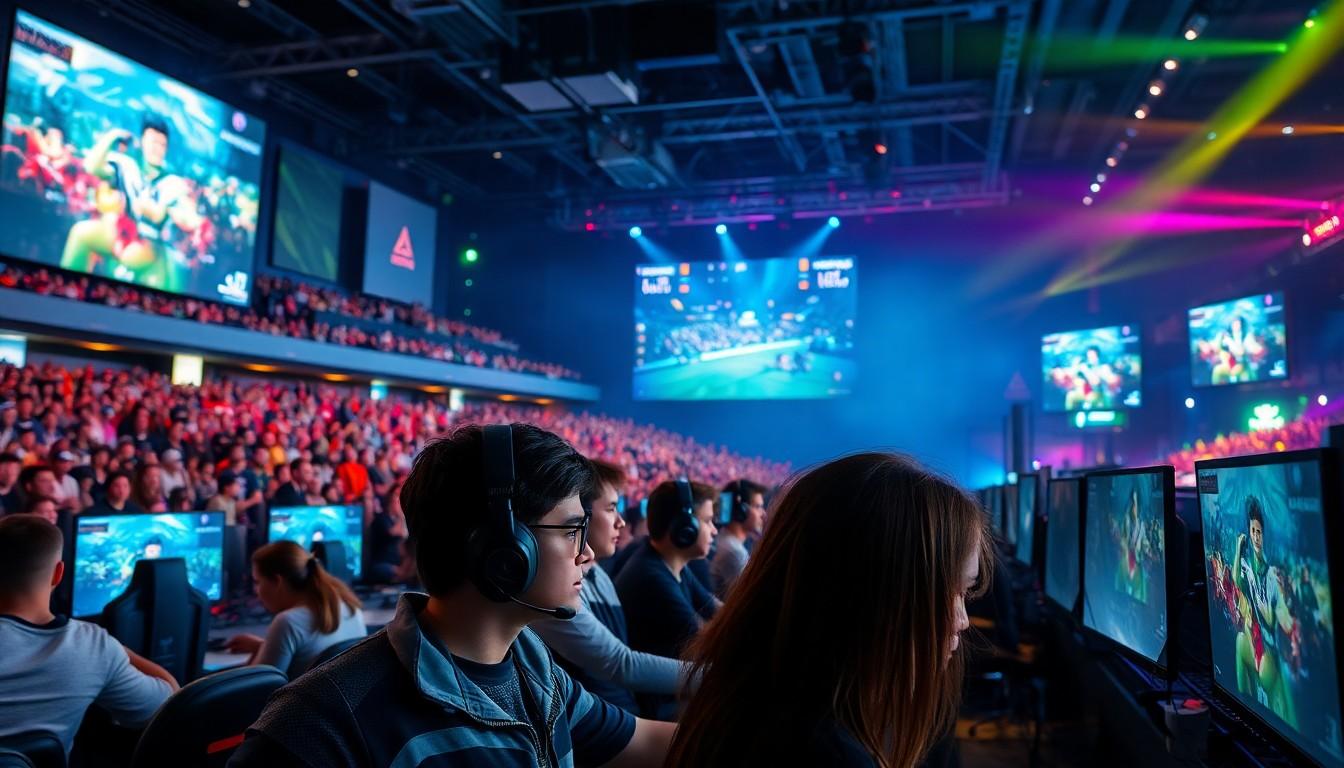In the fast-paced world of gaming, esports has skyrocketed from a niche hobby to a global phenomenon. With millions glued to their screens, the competition is fierce, and the stakes are higher than ever. In 2022, gamers weren’t just playing—they were battling it out in arenas that rival the excitement of the Super Bowl, complete with cheering fans and jaw-dropping plays.
So what were the hottest titles that had players glued to their screens and fans on the edge of their seats? From strategic shooters to fantastical realms, the most popular esports games of 2022 showcased skill, teamwork, and, let’s be honest, a fair share of epic fails that left everyone laughing. Dive in as we explore the games that not only captured hearts but also reshaped the esports landscape, proving once again that gaming is not just play—it’s a serious business.
Overview Of Most Popular Esports Games 2022
Esports in 2022 highlighted several games that captured players’ and audiences’ attention. Titles like League of Legends, Dota 2, and Counter-Strike: Global Offensive consistently ranked among the most viewed and played.
League of Legends attracted a massive global audience with its strategic gameplay and active competitive scene. This title hosted multiple tournaments, offering millions in prize money. Players displayed incredible teamwork and skill, enhancing its popularity further.
Dota 2 continued to dominate the esports landscape with events such as The International. The grandeur of this tournament drew viewers worldwide, making it one of the most prestigious events. Gamers engaged in intense battles, showcasing their deep understanding of mechanics and strategies.
Counter-Strike: Global Offensive remained a staple for competitive gaming and scored high in viewer counts. Its fast-paced action and tactical depth appealed to both players and fans. Frequent tournaments contributed to its enduring presence in the esports community.
Valorant emerged as a popular newcomer, blending classic FPS elements with unique character abilities. Released in 2020, it quickly gained traction and established a growing competitive scene. Its distinct gameplay mechanics attracted many aspiring esports players.
Other popular titles included Fortnite, known for its battle royale format, and Call of Duty: Warzone, maintaining a loyal player base. They provided players with diverse gameplay experiences while drawing large audiences to tournaments.
Overall, these titles exemplified the evolution of gaming as a competitive sport in 2022. Each game contributed uniquely to the esports ecosystem, offering thrilling moments and exceptional displays of skill.
Key Factors Influencing Popularity

Popularity in esports stems from various key factors. The size of the player base significantly impacts a game’s appeal and longevity.
Player Base Size
League of Legends boasts millions of active players, making it a top contender in the esports arena. Dota 2, with its dedicated community, challenges players while expanding its follower count. Counter-Strike: Global Offensive maintains a strong player base through its engaging mechanics and competitive nature. Valorant garners attention with its innovative gameplay and diverse characters, attracting both veterans and newcomers. Fortnite engages a younger demographic with its unique building features and cross-platform play. Growing player bases directly correlate to increased visibility, fostering greater interest in competitive play.
Tournament Prize Pools
Tournament prize pools act as a major draw for participants and viewers alike. The International’s $40 million prize pool signifies Dota 2’s prestige in competitive gaming. League of Legends’ World Championship regularly features multi-million dollar incentives, attracting elite players globally. Counter-Strike: Global Offensive offers substantial prize money at major events, ensuring high-stakes competition. Valorant’s tournaments, with their rapidly increasing prize pools, enhance the game’s appeal and legitimacy. Significant financial rewards create excitement, fueling participation and viewership across esports titles.
Top Esports Games Ranked
Several games emerged as leaders in the esports scene in 2022, each contributing uniquely to the competitive landscape. The following titles represent the pinnacle of popularity among players and viewers alike.
Game 1: League Of Legends
League of Legends captured immense global attention in 2022, boasting over 180 million monthly players. Its strategic gameplay requires teamwork and precise execution, drawing in audiences during major tournaments. Events like the World Championship offer prize pools exceeding $2 million. Players rely on diverse champions and constantly evolving strategies to outmaneuver opponents. The game’s strong community support further solidifies its position as a staple in esports.
Game 2: Dota 2
Dota 2 commanded significant recognition with its flagship event, The International, which reached a staggering prize pool of $40 million in 2022. Competitive gameplay involves intricate strategies and high-level mechanics, keeping viewers engaged. Millions of players actively participate in ranked matches, contributing to a vibrant ecosystem. Rigorous teamwork and communication play crucial roles in securing victory. The game’s consistent updates and competitive format maintain excitement within the player base.
Game 3: Counter-Strike: Global Offensive
Counter-Strike: Global Offensive maintained its status as a legendary competitive title, attracting audiences with thrilling, fast-paced action. Over 25 million players engage in frequent matches, showcasing varied skills through tactics and teamwork. Major tournaments, such as ESL Pro League, consistently offer substantial prize pools, exceeding $1 million. The game’s mechanics emphasize precision shooting and map knowledge, creating intense matches. CS:GO’s dedicated community and extensive esports infrastructure ensure its longevity.
Game 4: Valorant
Valorant emerged as a notable contender in the esports realm, blending traditional first-person shooter mechanics with character-based abilities. Its tactical gameplay attracted millions of players, with over 14 million monthly users in 2022. Competitive events, like the VCT Masters, showcase top-tier play and offer impressive prize pools. Players focus on utilizing unique character abilities strategically to gain advantages. Valorant’s vibrant community fosters a strong competitive atmosphere, driving growth in the esports sector.
Game 5: Call Of Duty
Call of Duty captured significant attention in the esports landscape, fueled by its fast-paced gameplay and engaging storylines. The franchise’s Warzone mode has attracted millions, creating a thriving community with competitive events. Tournaments, including the Call of Duty League, consistently feature hefty prize pools, often surpassing $1 million. Players rely on diverse strategies and teamwork to achieve victory. Its dynamic gameplay and immersive experiences ensure continued popularity within the esports sphere.
The Impact Of Streaming Platforms
Streaming platforms significantly influence esports popularity. Platforms like Twitch and YouTube Gaming serve as primary venues for game streaming and content creation. Viewers engage with live broadcasts, enhancing community interactions through chat features and social media integration. These interactions cultivate loyal fanbases, turning casual watchers into dedicated participants.
Gaming platforms leverage their unique user-generated content. Highlighting top players and memorable moments attracts attention to specific games. Major titles see increased viewership during tournaments due to streaming events that draw millions of spectators. For example, League of Legends events consistently rank among the most-watched broadcasts, contributing to its huge player base of over 180 million monthly users.
Monetization strategies on these platforms also play a crucial role. Advertisements, sponsorships, and subscriptions generate significant revenue for streamers, incentivizing them to create high-quality content. They often showcase gameplay of popular titles like Dota 2 and Counter-Strike: Global Offensive, further elevating these games within the competitive scene.
Moreover, real-time interactions between streamers and viewers forge connections beyond mere observation. Chats allow for instant feedback and discussions, enabling audiences to align more closely with their favorite games. Valorant, the compelling FPS that attracts over 14 million users, benefits greatly from such community engagement, driving interest and participation.
Ultimately, streaming platforms reshape not only how audiences consume esports but also how games evolve. The attractive streaming milieu propels titles like Fortnite and Call of Duty: Warzone into the limelight. Healthy competition blossoms as players seek recognition and fame, leading to a dynamic esports ecosystem.
Future Trends In Esports
Emerging technologies promise to shape the future of esports significantly. Virtual reality and augmented reality present new gameplay experiences, enhancing immersion for players and spectators alike. Integration of blockchain technology offers potential for secure transactions and ownership, revolutionizing in-game assets and player rewards.
Increased investment in esports infrastructure plays a crucial role in growing the industry. Major brands and organizations pour funding into teams and tournaments, elevating the overall competition quality. Partnerships between esports teams and traditional sports franchises pave the way for cross-promotional opportunities, broadening audience reach.
Adoption of mobile gaming continues to expand the esports landscape. Title such as PUBG Mobile and Mobile Legends: Bang Bang see rising participation rates and competitive events, appealing to a broader audience. Tournament organizers focus on accessibility, creating formats that reach diverse demographics.
Sustainability practices emerge as another vital trend. Teams and organizations implement eco-friendly strategies, addressing environmental concerns while engaging socially conscious fans. Companies also leverage their platforms for advocacy, building a supportive community around shared values.
Data analytics drive performance improvements in competitive play. Esports teams increasingly analyze gameplay statistics to refine strategies and tactics. Coaches utilize insights to enhance training regimens, giving players a competitive edge in high-stakes matches.
Lastly, fan engagement evolves through interactive content. Communities engage with games via social media and live chat during streams, forging stronger connections between players and audiences. Innovations in fan experiences, such as exclusive in-game events and behind-the-scenes content, keep viewers invested in esports narratives.
Conclusion
The esports landscape in 2022 showcased an impressive blend of skill excitement and community engagement. With popular titles like League of Legends Dota 2 and Valorant captivating millions it’s clear that competitive gaming has cemented its place in mainstream culture. The growth of streaming platforms has further amplified this phenomenon fostering dedicated fanbases and driving viewership to new heights.
As technology continues to evolve so will the esports industry. Emerging trends such as mobile gaming and sustainable practices promise to reshape the competitive scene. The future looks bright for esports as it continues to attract players fans and investors alike. The thrilling moments and strategic depth of these games ensure they remain at the forefront of entertainment for years to come.

